 Judging from the birds that are singing and chirping outside our tent, the sun is up. We do not notice any difference in our tent, because it is still dark as the dense jungle stops every sunbeam from hitting our tent. It is cold. The Nyungwe National Park is situated at 2500m. That is pretty good during the day, but at night it can be quite chilly. We have no desire to come out of our warm sleeping bag and certainly no desire to use the cold water in the shower. But we will have to, because today we have another long day ahead: crossing the border with Burundi.
Judging from the birds that are singing and chirping outside our tent, the sun is up. We do not notice any difference in our tent, because it is still dark as the dense jungle stops every sunbeam from hitting our tent. It is cold. The Nyungwe National Park is situated at 2500m. That is pretty good during the day, but at night it can be quite chilly. We have no desire to come out of our warm sleeping bag and certainly no desire to use the cold water in the shower. But we will have to, because today we have another long day ahead: crossing the border with Burundi.
After we have taken all our gear up to the bikes and had breakfast, we start the bikes. The first part of the route we drive back on the ’racetrack’ through the park in the direction of Lake Kivu. Despite the cold start of the day, we have red cheeks and a smile on our face after half an hour because of the great curves!
 We drive along the tea plantations to the lake, where we turn east to go to Burundi. The National Park was at 2,500 meters, but we now declining rapidly. Once we reach the swampy border triangle of Rwanda, Congo and Burundi the GPS indicates that we are only 100 meters above sea level. It is also quite a bit warmer. We arrive at the border with Burundi and drive onto a large abandoned parking lot. Apart from a few people who will cross the border on foot, it is deserted.
We drive along the tea plantations to the lake, where we turn east to go to Burundi. The National Park was at 2,500 meters, but we now declining rapidly. Once we reach the swampy border triangle of Rwanda, Congo and Burundi the GPS indicates that we are only 100 meters above sea level. It is also quite a bit warmer. We arrive at the border with Burundi and drive onto a large abandoned parking lot. Apart from a few people who will cross the border on foot, it is deserted.
We park next to a modern building which has both the flag of Rwanda and the flag of Burundi on its roof. That is something we have not seen before; two countries that share one building on the border. Usually we drive out of one country, then a few hundred meters through no man’s land, and then into the other country. We enter the building on the Rwandan side. Above the desk hangs a large portrait of the President of Rwanda and in addition a smaller portrait of the President of Burundi. Again something we will not see at every border crossing.
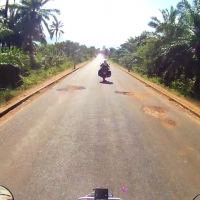 We are assisted by a Rwandan customs officer and receive outgoing stamps in our documents. Then another customs official steps forward, with the Burundi flag on his uniform. We first have to obtain a visa to enter the country. We usually ask for a single-entry visa (which allows you to enter the country once) that is valid for three months. Such visas cost us around $40 or $50. In Burundi, the prices are a bit higher. A single-entry visa that is valid several months will cost $80 per visa and even a transit-visa for three days costs $40. That does not really invite people to visit the country. No wonder many overlanders decide to skip Burundi and travel directly from Rwanda to Tanzania.
We are assisted by a Rwandan customs officer and receive outgoing stamps in our documents. Then another customs official steps forward, with the Burundi flag on his uniform. We first have to obtain a visa to enter the country. We usually ask for a single-entry visa (which allows you to enter the country once) that is valid for three months. Such visas cost us around $40 or $50. In Burundi, the prices are a bit higher. A single-entry visa that is valid several months will cost $80 per visa and even a transit-visa for three days costs $40. That does not really invite people to visit the country. No wonder many overlanders decide to skip Burundi and travel directly from Rwanda to Tanzania.
We would like to see Lake Tanganyika and follow that lake southward from Burundi on. We have heard good reports about the country and its people, so decide not to skip it. We opt for the slightly cheaper transit visa, which gives us three days to get to the border with Tanzania. It will be a very short visit, but three days does give us plenty of time to ride through the small country without having to hurry. We pay $80 for two visas and get beautiful stamps in our passports.
 Now we only need a Burundian stamp in our carnet. This time we do have to go to the other side of the building. Also on that side are portraits of both presidents, only this time the President of Burundi has a slightly larger picture. We help the official behind the counter to fill out the carnet, get our stamps and put everything away so that we can continue.
Now we only need a Burundian stamp in our carnet. This time we do have to go to the other side of the building. Also on that side are portraits of both presidents, only this time the President of Burundi has a slightly larger picture. We help the official behind the counter to fill out the carnet, get our stamps and put everything away so that we can continue.
We drive to the end of the parking lot and stop just before the closed gate. The young soldier at the gate asks for our passports. We had counted on this and have our passports ready. But that is not all, he also wants to see our stamped carnet (for the first time since Sudan this suddenly is important). Ai, I had just stowed those very far away. On ’bordercrossing-days’ I usually keep the carnets in a waterproof A4 pouch around my neck. On other days we keep them in one of the bags, but we would rather not open the bags at the border unless we have to. I start to peel off again; take of my gloves, my glasses, my helmet, my coat, take the pouch of my neck and then take the carnets from the pouch.  We stand in the blazing sun, it is very warm. Once the soldier has had a quick glance at the documents, I start to put everything on again in reverse order. The barrier opens and not long after that we also open the throttle. We are happy to ride again to cool off!
We stand in the blazing sun, it is very warm. Once the soldier has had a quick glance at the documents, I start to put everything on again in reverse order. The barrier opens and not long after that we also open the throttle. We are happy to ride again to cool off!
We drive through a flat, swampy area. The road just after the border was still pretty good, but it is getting worse. The further we drive into Burundi, the bigger the holes in the road are. We drive through farming villages with small shops on the main street. There are many people and animals on the streets. They seem to see more Westerners here, but probably not as often on motorcycles. People stop along the side of the road and look at us in amazement.
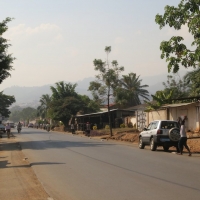 After the clean and developed Rwanda, Burundi is something else. Burundi is one of the poorest countries in the world which we notice immediately. Not only the road is in bad condition, the same applies to the houses. The clothing of the people is old and worn and the majority of them do not wear shoes. And here we again see a remarkable number of women and children with big jerry cans on their backs to fetch water. We understand that almost 85% of the population has no access to clean drinking water, electricity and medical care.
After the clean and developed Rwanda, Burundi is something else. Burundi is one of the poorest countries in the world which we notice immediately. Not only the road is in bad condition, the same applies to the houses. The clothing of the people is old and worn and the majority of them do not wear shoes. And here we again see a remarkable number of women and children with big jerry cans on their backs to fetch water. We understand that almost 85% of the population has no access to clean drinking water, electricity and medical care.
As in Ethiopia, we see a great number of signs along the road that refer to the various aid organizations. They state what the project entails and by whom it is financed. The projects focus on schooling, road construction, training of midwives, clean water, you name it. In Ethiopia we noticed the presence of the Americans, here in Burundi the North European countries are strongly represented. We see several signs with a Dutch, Norwegian or Danish flag painted on them. We also come across a number of offices of WarChild, the Dutch organization that is dedicated to the development of children that have unfortunately experienced war. Just like Uganda and Rwanda, Burundi has been suffering from ethnic conflicts for a long time. In Burundi the situation still is relatively unstable, as a result of which the country has not had a chance to develop. A big difference with Uganda and Rwanda.
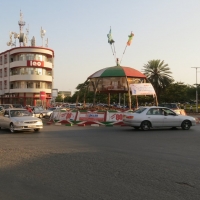 At the end of a long, hot day on bad roads we arrive in Buyumbura, the capital of Burundi. On the advice of Ard and Tania, we find a nice clean room at Hotel Mombasa. We drag all our stuff up that stairs and rinse off the dust. There is no hot water in the shower, but even cold water is great after a trip like today. We walk to the centre of town to eat and find a hip dining café where they serve a delicious piece of meat with French fries (perhaps the only positive point of the colonization by Belgium). We walk through the city before we go back to our hotel, passing the market, the coloured shops and old colonial buildings. It is still early when we get back to our room, but we are both so tired that we fall asleep after reading only a few pages in our book.
At the end of a long, hot day on bad roads we arrive in Buyumbura, the capital of Burundi. On the advice of Ard and Tania, we find a nice clean room at Hotel Mombasa. We drag all our stuff up that stairs and rinse off the dust. There is no hot water in the shower, but even cold water is great after a trip like today. We walk to the centre of town to eat and find a hip dining café where they serve a delicious piece of meat with French fries (perhaps the only positive point of the colonization by Belgium). We walk through the city before we go back to our hotel, passing the market, the coloured shops and old colonial buildings. It is still early when we get back to our room, but we are both so tired that we fall asleep after reading only a few pages in our book.
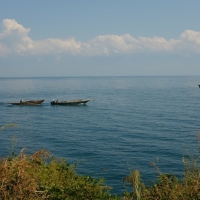 Although New York is known as “The city that never sleeps” Buyumbura could also take a shot at that title. It has not been quiet all night. Taxis drove back and forth, people on the street were yelling at their neighbour or sang along with the loud music. Even ear plugs could not prevent that we woke up a few times. We both take another cold shower to wake up after the rough night and go back on the road.
Although New York is known as “The city that never sleeps” Buyumbura could also take a shot at that title. It has not been quiet all night. Taxis drove back and forth, people on the street were yelling at their neighbour or sang along with the loud music. Even ear plugs could not prevent that we woke up a few times. We both take another cold shower to wake up after the rough night and go back on the road.
The northern most point of Lake Tanganyika is in Buyumbura. It is Africa’s deepest lake (maximum depth 1,470 meters) and the longest freshwater lake in the world. We are going to ride along the lake for a while, starting in Buyumbura. We ride right next to the lake, along the clear blue water, white beaches and palm trees. A tropical paradise. It is also still tropically warm, but the wind that comes from the lake makes it very pleasant. We drive through small fishing villages where dozens of colourful boats are floating on the water. On the beach are wooden racks where fish is dried. As we drive along, the fishermen keep the catch of the day high up in the air and try to sell it to us.
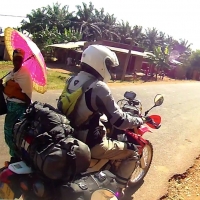 In the afternoon we arrive in Nyanza Lac, a small town on Lake Tanganyika in the south of Burundi. There are three hotels, which are mostly visited by the volunteers and UN staff working in Burundi. At the reception they are quite surprised when we tell them that we are tourists, they do not get those here often. We get a nice room and quickly swap our motorcycle gear for swimwear to take a dip in the lake. It is great! Not long after we have plunged into the water, the local youth also comes and have a look. And I literally mean ’a look’, because the boys swim towards us one by one, dive underwater and then come back up giggling to shout something to their friends about the ’Mzungu’. A female white woman in her bikini who has not been in the sun for some months and is almost blindingly white. That would also make me giggle!
In the afternoon we arrive in Nyanza Lac, a small town on Lake Tanganyika in the south of Burundi. There are three hotels, which are mostly visited by the volunteers and UN staff working in Burundi. At the reception they are quite surprised when we tell them that we are tourists, they do not get those here often. We get a nice room and quickly swap our motorcycle gear for swimwear to take a dip in the lake. It is great! Not long after we have plunged into the water, the local youth also comes and have a look. And I literally mean ’a look’, because the boys swim towards us one by one, dive underwater and then come back up giggling to shout something to their friends about the ’Mzungu’. A female white woman in her bikini who has not been in the sun for some months and is almost blindingly white. That would also make me giggle!
The next day we stay in Nyanza Lac to do some more swimming and to try to get a tan after all. We use their high-speed internet, help the bartender to practice his English and enjoy the beautiful views over the lake. The next morning it time to leave the country on the third and final day of our ‘transit visa’
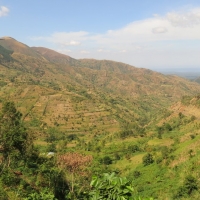 To get to the border with Tanzania we first need to ride inland, towards Mabanda. We drive from the lake to the east, into the hills. After several steep turns, we have already ascended a lot and now have a beautiful view over the lake. Until Mabanda we follow a paved road, but once we enter the town we come onto a dusty dirt road. We see some people along the way who are eagerly waving at us. This happens quite often, but this time they also call ‘Police, Police’. Once we have stopped to listen more carefully, they tell us that the customs office is here in Mabanda, at 20km before the border. We follow the instructions of the bystanders and then find the police station and the customs officer. We get stamps in our passports and carnet and are on our way again after 15 minutes. That was really fast.
To get to the border with Tanzania we first need to ride inland, towards Mabanda. We drive from the lake to the east, into the hills. After several steep turns, we have already ascended a lot and now have a beautiful view over the lake. Until Mabanda we follow a paved road, but once we enter the town we come onto a dusty dirt road. We see some people along the way who are eagerly waving at us. This happens quite often, but this time they also call ‘Police, Police’. Once we have stopped to listen more carefully, they tell us that the customs office is here in Mabanda, at 20km before the border. We follow the instructions of the bystanders and then find the police station and the customs officer. We get stamps in our passports and carnet and are on our way again after 15 minutes. That was really fast.
We drive through Mabanda and follow an off-road path towards the border with Tanzania. The road is in very poor condition, with deep grooves we avoid by we zigzag around them with the bikes. After 18km we see another police station along the way where a Burundi flag flutters.  The policeman waves from his chair and gestures that we should come to see him. We show him our stamped papers and then drive on. We ride for a few more kilometres and then see the border in the distance. There is no flag, no sign and no barrier, yet it is very clear that we are at the border. Right between the two border poles a beautiful asphalt road starts, the difference with the ‘road’ in Burundi could not be bigger!
The policeman waves from his chair and gestures that we should come to see him. We show him our stamped papers and then drive on. We ride for a few more kilometres and then see the border in the distance. There is no flag, no sign and no barrier, yet it is very clear that we are at the border. Right between the two border poles a beautiful asphalt road starts, the difference with the ‘road’ in Burundi could not be bigger!
Click here to view the photos.
Distance travelled to Nyanza Lac: 18,049km (11,215 miles)
Previous story “Congo-Nile Trail” – Next story “In search of Livingstone“





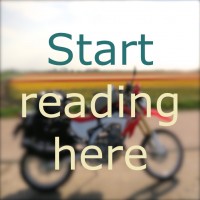


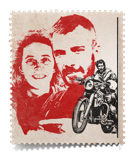
Ik heb nog steeds het gevoel dat ik met jullie mee reis. Prachtig!
Prachtig weer. Leuk ook het regenwoud van Nyungwe!
Vergeet niet ook een beetje bij te bruinen anders gelooft straks niemand jullie Afrikaanse avontuur